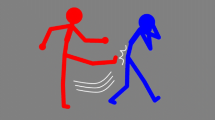Abstract
Three experiments examined the temporal course of the activation of an antecedent triggered by a reflexive,jibun, in syntactically ambiguous sentences in Japanese. Twenty-two students in Experiment 1 were tested for sentences where a subject word occupied the first position and an indirect object word the second, with the probe given for each word either immediately after the reflexive or at the end of the sentence. Reaction times (RTs) were faster when the probe was for subject (S-probe) than when it was for indirect object (IO-probe) irrespective of the probe position. Experiment 2 tested 22 students to determine the effect of order of mention of participant on the probe recognition time. RTs were faster for the S-probe than for the IO-probe, although the difference between the two probes was smaller when the probe was given immediately after the reflexive. Experiment 3 tested 22 students to examine the effect of context on an activation pattern. RTs were lower for the S-probe than for the IO-probe, though no difference was found between them for the probe given at the end of the sentence. Findings were interpreted as supporting the single-interpretation model for on-line analysis of syntactically ambiguous sentences and also the immediate-activation model in an assignment of the reflexive to its antecedent.
Similar content being viewed by others
References
Chang, F. (1980). Active memory processes in visual sentence processing: Clause effects and pronominal reference.Memory and Cognition, 8, 58–64.
Dell, G. S., McKoon, G., & Ratcliff, R. (1983). The activation of antecedent information during the processing of anaphoric reference in reading.Journal of Verbal Learning and Verbal Behavior, 22, 121–132.
Duffy, S. A., Morris, R. K., & Rayner, K. (1988). Lexical ambiguity and fixation times in reading.Journal of Memory and Language, 27, 429–446.
Ferreira, F., & Clifton, C., Jr. (1986). The independence of syntactic processing.Journal of Memory and Language, 25, 348–368.
Frazier, L., & Rayner, K. (1982). Making and correcting errors during sentence comprehension: Eye movements in the analysis of structurally ambiguous sentences.Cognitive Psychology, 14, 178–210.
Frazier, L., & Rayner, K. (1987). Resolution of syntactic category ambiguities: Eye movements in parsing lexically ambiguous sentences.Journal of Memory and Language, 26, 505–526.
Gernsbacher, M. A., & Hargreaves, D. J. (1988). Accessing sentence participants: The advantage of first mention.Journal of Memory and Language, 27, 699–717.
Inoue, K. (1976).Henkeibunpo to nihongo: Ge (Transformational grammar and Japanese: Vol. 2). Tokyo: Taishukan Shoten.
Kennedy, A., Murray, W. S., Jennings, F., & Reid, C. (1989). Parsing complements: Comments on the generality of the principle of minimal attachment.Language and Cognitive Processes, 4, 51–76.
Kirk, R. E. (1982).Experimental design: Procedures for the behavioral sciences (2nd ed.). Pacific Grove, CA: Brooks/Cole.
Kuno, S. (1973).Nihon Bunpo Kenkyu (The structure of the Japanese language). Tokyo: Taishukan Shoten.
McElree, B., & Bever, T. G. (1989). The psychological reality of linguistically defined gaps.Journal of Psycholinguistic Research, 18, 21–35.
McKoon, G., Ratcliff, R. (1980). The comprehension processes and memory structures involved in anaphoric reference.Journal of Verbal Learning and Verbal Behavior, 19, 668–682.
Nicol, J., & Swinney, D. (1989). The role of structure in coreference assignment during sentence comprehension.Journal of Psycholinguistic Research, 18, 5–19.
Nihon Shinrigakkai Kaiin Meibo (1988). (The Register of the members of Japanese Psychological Association). Tokyo: Nihon Shinrigakkai.
O'Brien, E. J., Duffy, S. A., & Myers, J. L. (1986). Anaphoric inference during reading.Journal of Experimental Psychology: Learning, Memory, and Cognition, 12, 346–352.
Rayner, K., Carlson, M., & Frazier, L. (1983). The interaction of syntax and semantics during sentence processing: Eye movements in the analysis of semantically biased sentences.Journal of Verbal Learning and Verbal Behavior, 22, 358–374.
Rayner, K., & Frazier, L. (1987). Parsing temporarily ambiguous complements.Quarterly Journal of Experimental Psychology, 39A, 657–673.
Seidenberg, M. S., Tanenhaus, M. K., Leiman, J. M., & Bienkowski, M. (1982). Automatic access of the meaning of ambiguous words in context: Some limitations to knowledge-based processing.Cognitive Psychology, 14, 489–537.
Stevenson, R. J., & Vitkovitch, M. (1986). The comprehension of anaphoric relations.Language and Speech, 29, 335–360.
Swinney, D. A. (1979). Lexical access during sentence comprehension: (Re)consideration of context effects.Journal of Verbal Learning and Verbal Behavior, 18, 645–660.
Tanenhaus, M. K., & Donnenwerth-Nolan, S. (1984). Syntactic context and lexical ambiguity.Quarterly Journal of Experimental Psychology, 36A, 649–661.
Author information
Authors and Affiliations
Rights and permissions
About this article
Cite this article
Nagata, H. Temporal course of activation of the antecedent by the reflexive in syntactically ambiguous sentences in Japanese. J Psycholinguist Res 20, 501–520 (1991). https://doi.org/10.1007/BF01067640
Accepted:
Issue Date:
DOI: https://doi.org/10.1007/BF01067640




